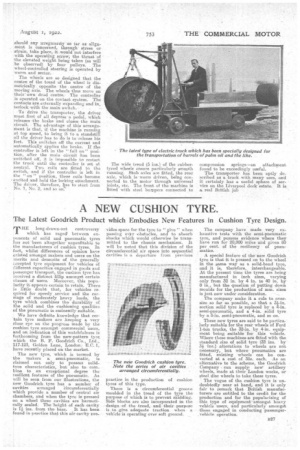A NEW CUSHION TYRE.
Page 11

If you've noticed an error in this article please click here to report it so we can fix it.
The Latest Goodrich Product which Embodies New Features in Cushion Tyre Design.
THE long-drawn-out controversy which has raged between exponents of solid and pneumatic tyres has not been altogether unprofitable to the manufacturers of cushion tyres. In fact, whilst differences of opinion have existed amongst makers and users on the merits and dernorite of the generally ecepted tyre equipment for vehicles of different capacities engaged in goods and passenger transport, the cushion tyre has received a distinct fillip amongst certain classes of risers. Moreover, this popu. larity it. appears certain to retain. There is littlo doubt that, for vehicles required for speedy service and the carriage of moderately heavy loads, the tyre which combines the durability of the solid and the cushioning qualities of the pneumatic is eminently suitable.
We have definite knowledge that certain tyre makers are ,keeping a very close eye on the progress made by the cushion tyre, amongst commercial users, and an indication of this watchfulness is forthcoming from the new-pattern tyre which the B. F. Goodrich Co., Ltd., 117-123, Golden Lane, London. E.C. 1, have recently placed on the market.
The new tyre, which is termed by the makers a semi-pneumatic, Is claimed not only to possess solidtyre characteristics, but also to combine to an exceptional degree the resilient features of the pneumatic. As will be seen from our illustrations, the new Goodrich tyre has a number of cavities arranged -circumfe rend ally which provide a number of central air chambers, and when the tyre is pressed on a wheel these cavities are hermetically sealed. The 'height of each cavity is 11 ius, from the base. It has been found in practice that this air cavity pro
vides space for the tyre to " give " when passing oy'sn• -obstacles, and to absorb shocks which would otherwise be transmitted to the chassis mechanism. It will be noted that this division of the circumferential air space into sequential cavities is a departure from previous practice in the production of cushion tyres of this type.
There is a circumferential groove moulded in the tread of the tyre the purpose of which is to prevent skidding. Side blocks are also incorporated in the design of the tread, and their purpose is to give adequate traction when a vehicle is operating over soft ground.
The company have made very exhaustive tests with the semi-pneumatic tyre, and possess evidence -where they have run for 20,000 miles and given 80 per cent, of the resiliency of pneumatics.
A special feature of the new Goodrich tyre is that it is pressed on to the wheel in the same way as a solid-hand tyre, and it is, therefore, interchangeable. At the present time the tyres are being manufactured in inch sizes, varying only from 32 in. by 4 in. to 40 in. by 8 in., but the question of putting down moulds for the production of mm. sizes is just now under consideration.
The company make it a rule to oversize so far as possible, so that a 3i-in. section solid tyre is replaced by a 4-in. semi-pneumatic, and a 4-in, solid tyre by a 5-in, semi-pneumatic, and so on.
These new tyres are said to be particularly suitable for the rear wheels of Ford 1-ton trucks, the 32-in. by 4-in. equipment being suitable for this vehicle. Where these machines are fitted with the standard size of solid tyre (32 ins. by 3i ins.) alterations to wheels are not necessary, but where pneumatics are fitted, existing wheels can be con.. vested at a cost of 35s. each. As an alternative to the scheme, the Goodrich Company ... can supply new' artillery wheels, made at their London works, or steel disc wheels to take these tyres.
The vogue of the cushion tyre is undoubtedly near at hand, and it is only fair to remark that British manufacturers are entitled to the credit for the production and for the popularizing of this type of equipment -amongst heavy vehicle users, and particularly amongst those engaged in conducting passengervehicle operation.






























